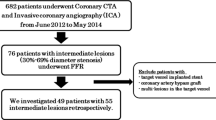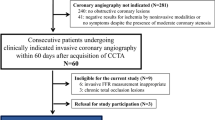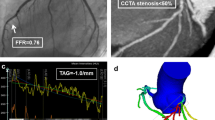Abstract
Objectives
Coronary CT angiography (cCTA) has been used to non-invasively assess both the anatomical and hemodynamic significance of coronary stenosis. The current study investigated a new CFD-based method of evaluating pressure-flow curves across a stenosis to further enhance the diagnostic value of cCTA imaging.
Methods
Fifty-eight patients who underwent both cCTA imaging and invasive coronary angiography (ICA) with fractional flow reserve (FFR) within 2 weeks were enrolled. The pressure-flow curve–derived parameters, viscous friction (VF) and expansion loss (EL), were compared with conventional cCTA parameters including percent area stenosis (AS) and minimum lumen area (MLA) by receiver operating characteristic (ROC) curve analysis. FFR ≤ 0.80 was used to indicate ischemia-causing stenosis. Correlations between FFR and other measurements were calculated by Spearman’s rank correlation coefficient (rho).
Results
Sixty-eight stenoses from 58 patients were analyzed. VF, EL, and AS were significantly larger in the group of FFR ≤ 0.8 while smaller MLA values were observed. The ROC-AUC of VF (0.91, 95% CI 0.81–0.96) was better than that of AS (change in AUC (ΔAUC) 0.27, p < 0.05) and MLA (ΔAUC 0.17, p < 0.05), and ROC-AUC of EL (0.90, 95%CI 0.80–0.96) was also better than that of AS (ΔAUC 0.26, p < 0.05) and MLA (ΔAUC 0.16, p < 0.05). FFR values correlated well with VF (rho = − 0.74 (95% CI − 0.83 to − 0.61, p < 0.0001) and EL (rho = − 0.74 (95% CI − 0.83 to − 0.61, p < 0.0001).
Conclusion
Pressure-flow curve–derived parameters enhance the diagnostic value of cCTA examination.
Key Points
• Pressure-flow curve derived from cCTA can assess coronary lesion severity.
• VF and EL are superior to cCTA alone for indicating ischemic lesions.
• Pressure-flow curve derived from cCTA may assist in clinical decision-making.




Similar content being viewed by others
Abbreviations
- AS:
-
Area stenosis
- AUC:
-
Area under the receiver operator characteristic curve
- CAD:
-
Coronary artery disease
- cCTA:
-
Coronary computed tomographic angiography
- CDP:
-
Pressure drop coefficient
- CFD:
-
Computational fluid dynamic
- EL:
-
Expansion loss
- FFR:
-
Fractional flow reserve
- FFR-CT:
-
Fractional flow reserve derived from coronary computed tomographic angiography
- HU:
-
Hounsfield units
- ICA:
-
Invasive coronary angiography
- MLA:
-
Minimum lumen area
- Rho:
-
Spearman’s rank correlation coefficient
- ROC:
-
Receiver operating characteristic
- ROI:
-
Region of interest
- VF:
-
Viscous friction
References
Pijls NHJ, Sels J-WEM (2012) Functional measurement of coronary stenosis. J Am Coll Cardiol 59:1045–1057
Fearon WF, Nishi T, De Bruyne B et al (2018) Clinical outcomes and cost-effectiveness of fractional flow reserve-guided percutaneous coronary intervention in patients with stable coronary artery disease: three-year follow-up of the FAME 2 trial (Fractional Flow Reserve Versus Angiography for Multive). Circulation 137:480–487
Tonino PAL, De Bruyne B, Pijls NHJ et al (2009) Fractional flow reserve versus angiography for guiding percutaneous coronary intervention. N Engl J Med 360:213–224
De Bruyne B, Fearon WF, Pijls NHJ et al (2014) Fractional flow reserve–guided PCI for stable coronary artery disease. N Engl J Med 371:1208–1217
Pothineni NV, Shah NS, Rochlani Y et al (2016) U.S. trends in inpatient utilization of fractional flow reserve and percutaneous coronary intervention. J Am Coll Cardiol 67:732–733
Miller JM, Rochitte CE, Dewey M et al (2008) Diagnostic performance of coronary angiography by 64-row CT. N Engl J Med 359:2324–2336
Meijboom WB, Meijs MFL, Schuijf JD et al (2008) Diagnostic accuracy of 64-slice computed tomography coronary angiography. A prospective, multicenter, multivendor study. J Am Coll Cardiol 52:2135–2144
Budoff MJ, Dowe D, Jollis JG et al (2008) Diagnostic performance of 64-multidetector row coronary computed tomographic angiography for evaluation of coronary artery stenosis in individuals without known coronary artery disease. Results from the prospective multicenter ACCURACY. J Am Coll Cardiol 52:1724–1732
Douglas PS, Hoffmann U, Patel MR et al (2015) Outcomes of anatomical versus functional testing for coronary artery disease. N Engl J Med 372:1291–1300
Taylor CA, Fonte TA, Min JK (2013) Computational fluid dynamics applied to cardiac computed tomography for noninvasive quantification of fractional flow reserve: scientific basis. J Am Coll Cardiol 61:2233–2241
Ashikaga H, Coppola BA, Yamazaki KG et al (2008) Changes in regional myocardial volume during the cardiac cycle: implications for transmural blood flow and cardiac structure. Am J Physiol Heart Circ Physiol 295:610–618
Mejía-Rentería H, Lauri FM, Lee JM et al (2019) Interindividual variations in the adenosine-induced hemodynamics during fractional flow reserve evaluation: implications for the use of quantitative flow ratio in assessing intermediate coronary stenoses. J Am Heart Assoc 8:e012906
Young DF, Tsai FY (1973) Flow characteristics in models of arterial stenoses — I. Steady flow. J Biomech 6:395–402
Xie X, Zheng M, Wen D, Li Y, Xie S (2018) A new CFD based non‑invasive method for functional diagnosis of coronary stenosis. Biomed Eng Online 17:36
De Bruyne B, Pijls NH, Barbata E et al (2003) Intracoronary and intravenous adenosine 5′-triphosphate, adenosine, papaverine, and contrast medium to assess fractional flow reserve in humans. Circulation 107:1877–1883
DeLong ER, DeLong DM, Clarke-Pearson DL (1988) Comparing the areas under two or more correlated receiver operating characteristic curves: a nonparametric approach. Biometrics 44:837–845
Van Mieghem CAG (2017) CT as gatekeeper of invasive coronary angiography in patients with suspected CAD. Cardiovasc Diagn Ther 7:189–195
Meijboom WB, Van Mieghem CAG, van Pelt N et al (2008) Comprehensive assessment of coronary artery Stenoses. Computed tomography coronary angiography versus conventional coronary angiography and correlation with fractional flow reserve in patients with stable angina. J Am Coll Cardiol 52:636–643
Koo BK, Erglis A, Doh JH et al (2011) Diagnosis of ischemia-causing coronary stenoses by noninvasive fractional flow reserve computed from coronary computed tomographic angiograms. Results from the prospective multicenter DISCOVER-FLOW (Diagnosis of Ischemia-Causing Stenoses Obtained Via Noni). J Am Coll Cardiol 58:1989–1997
Nakazato R, Park HB, Berman DS et al (2013) Noninvasive fractional flow reserve derived from computed tomography angiography for coronary lesions of intermediate stenosis severity: results from the DeFACTO study. Circ Cardiovasc Imaging 6:881–889
Norgaard BL, Leipsic J, Gaur S et al (2014) Diagnostic performance of noninvasive fractional flow reserve derived from coronary computed tomography angiography in suspected coronary artery disease: the NXT trial (Analysis of Coronary Blood Flow Using CT Angiography: Next Steps). J Am Coll Cardiol 63:1145–1155
Yu M, Lu Z, Shen C et al (2019) The best predictor of ischemic coronary stenosis: subtended myocardial volume, machine learning–based FFR CT, or high-risk plaque features? Eur Radiol 29:3647–3657
Coenen A, Kim Y-H, Kruk M et al (2018) Diagnostic accuracy of a machine-learning approach to coronary computed tomographic angiography–based fractional flow reserve. Circ Cardiovasc Imaging 11:e007217
Han H, Bae YG, Hwang ST et al (2019) Computationally simulated fractional flow reserve from coronary computed tomography angiography based on fractional myocardial mass. Int J Cardiovasc Imaging 35:185–193
Tang CX, Liu CY, Lu MJ et al (2019) CT FFR for ischemia-specific CAD with a new computational fluid dynamics algorithm. JACC Cardiovasc Imaging. https://doi.org/10.1016/j.jcmg.2019.06.018
Celeng C, Leiner T, Maurovich-Horvat P et al (2019) Anatomical and functional computed tomography for diagnosing hemodynamically significant coronary artery disease. JACC Cardiovasc Imaging 12:1316–1325
Cook CM, Petraco R, Shun-Shin MJ et al (2017) Diagnostic accuracy of computed tomography-derived fractional flow reserve a systematic review. JAMA Cardiol 2:803–810
Petraco R, Sen S, Nijjer S et al (2013) Fractional flow reserve-guided revascularization: practical implications of a diagnostic gray zone and measurement variability on clinical decisions. JACC Cardiovasc Interv 6:222–225
Ko BS, Cameron JD, Munnur RK et al (2017) Noninvasive CT-derived FFR based on structural and fluid analysis: a comparison with invasive FFR for detection of functionally significant stenosis. JACC Cardiovasc Imaging 10:663–673
Banerjee RK, Ashtekar KD, Effat MA et al (2009) Concurrent assessment of epicardial coronary artery stenosis and microvascular dysfunction using diagnostic endpoints derived from fundamental fluid dynamics principles. J Invasive Cardiol 21:511–517
Banerjee RK, Ashtekar KD, Helmy TA, Effat MA, Back LH, Khoury SF (2008) Hemodynamic diagnostics of epicardial coronary stenoses: in-vitro experimental and computational study. Biomed Eng Online 7:24
Kolli KK, Effat MA, Peelukhana SV et al (2014) Hyperemia-free delineation of epicardial and microvascular impairments using a basal index. Ann Biomed Eng 42:1681–1690
Kolli KK, van de Hoef TP, Effat MA et al (2016) Diagnostic cutoff for pressure drop coefficient in relation to fractional flow reserve and coronary flow reserve: a patient-level analysis. Catheter Cardiovasc Interv 87:273–282
Hebbar UU, Effat MA, Peelukhana SV, Arif I, Banerjee RK (2017) Delineation of epicardial stenosis in patients with microvascular disease using pressure drop coefficient: a pilot outcome study. World J Cardiol 9:813–821
Anagnostopoulos CD, Siogkas PK, Liga R et al (2019) Characterization of functionally significant coronary artery disease by a coronary computed tomography angiography-based index: a comparison with positron emission tomography. Eur Heart J Cardiovasc Imaging 0:1–9
Siogkas PK, Anagnostopoulos CD, Liga R et al (2019) Noninvasive CT-based hemodynamic assessment of coronary lesions derived from fast computational analysis: a comparison against fractional flow reserve. Eur Radiol 29:2117–2126
Funding
This study has received funding by the National Natural Science Foundation of China (Grant No. 61601368), the Fundamental Research Funds for the Central Universities (No. 3102018ZY021) and the Discipline promotion project of Xijing hospital (No. XJZT18MJ52).
Author information
Authors and Affiliations
Corresponding authors
Ethics declarations
Guarantor
The scientific guarantor of this publication is Minwen Zheng.
Conflict of interest
The authors of this manuscript declare no relationships with any companies whose products or services may be related to the subject matter of the article.
Statistics and biometry
No complex statistical methods were necessary for this paper.
Informed consent
Written informed consent was obtained from all subjects (patients) in this study.
Ethical approval
Institutional Review Board approval was obtained.
Methodology
• Retrospective
• Diagnostic or prognostic study
• Performed at one institution
Additional information
Publisher’s note
Springer Nature remains neutral with regard to jurisdictional claims in published maps and institutional affiliations.
Rights and permissions
About this article
Cite this article
Xie, X., Wen, D., Zhang, R. et al. Pressure-flow curve derived from coronary CT angiography for detection of significant hemodynamic stenosis. Eur Radiol 30, 4347–4355 (2020). https://doi.org/10.1007/s00330-020-06821-w
Received:
Revised:
Accepted:
Published:
Issue Date:
DOI: https://doi.org/10.1007/s00330-020-06821-w




